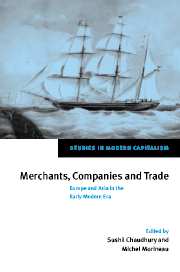Book contents
- Frontmatter
- Contents
- List of contributors
- Preface
- Introduction
- Part I Asia, especially India, around 1500
- Part II Routes, markets and merchants
- Part III European presence in Asia
- Part IV Implications of trade: Asia and Europe
- 13 The Indian challenge: seventeenth and eighteenth centuries
- 14 The changing pattern of British trade in Indian textiles,1701–1757
- 15 French traders and India at the end of the eighteenth century
- 16 The Asian merchants and companies in Bengal's export trade, circa mid-eighteenth century
- Index
13 - The Indian challenge: seventeenth and eighteenth centuries
Published online by Cambridge University Press: 02 December 2009
- Frontmatter
- Contents
- List of contributors
- Preface
- Introduction
- Part I Asia, especially India, around 1500
- Part II Routes, markets and merchants
- Part III European presence in Asia
- Part IV Implications of trade: Asia and Europe
- 13 The Indian challenge: seventeenth and eighteenth centuries
- 14 The changing pattern of British trade in Indian textiles,1701–1757
- 15 French traders and India at the end of the eighteenth century
- 16 The Asian merchants and companies in Bengal's export trade, circa mid-eighteenth century
- Index
Summary
Around 1680 a storm of protest blew up in England and France against the import of Indian cloths. Having become the height of fashion, they had begun to pour in by the boatload. They were threatening local textile industries – bosses and workmen alike. This led to bans which also covered the European imitations which had been encouraged by the success of the fashion and the existence of a market. Several studies have tackled the question in depth from the point of view of the objectors and in terms of the extent of the development and how it affected them. But the ‘invasion’ and the ‘assault’ as such have not been studied for their own sakes quite apart from the problems they caused; they have been banished to the limbo of a collective unconscious and ignored by the historians. My aim is to extract them from there and subject them to scrutiny, and thereby to make a contribution in a particular area to the debate on the confrontation between East and West in the seventeenth and eighteenth centuries. However, before tackling the part, I need to say something about the whole (independently of another comparison that will be found elsewhere), for the issue is not quite the same in the two cases. My plan will be found to flow logically from these prolegomena.
- Type
- Chapter
- Information
- Merchants, Companies and TradeEurope and Asia in the Early Modern Era, pp. 243 - 275Publisher: Cambridge University PressPrint publication year: 1999
- 2
- Cited by



